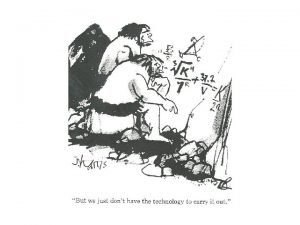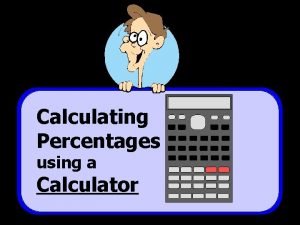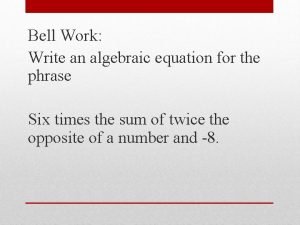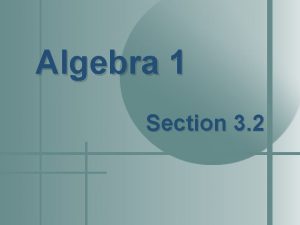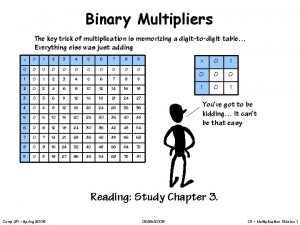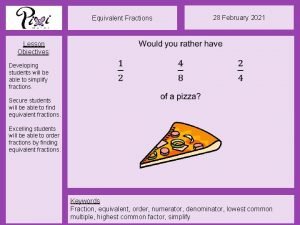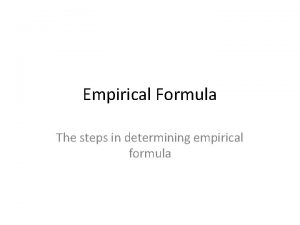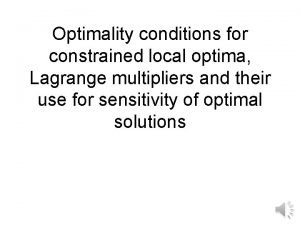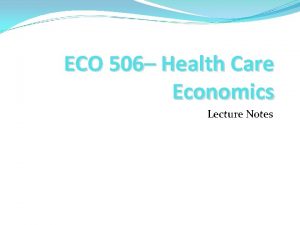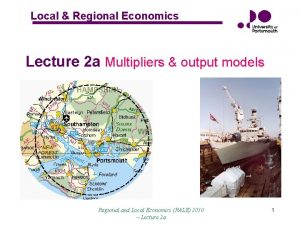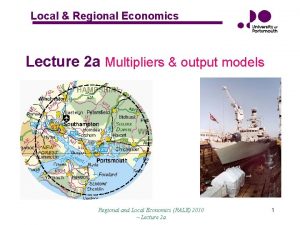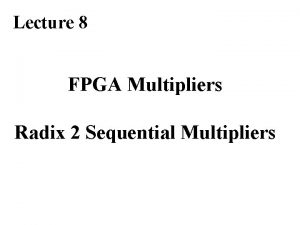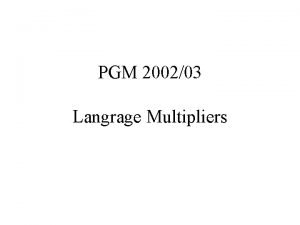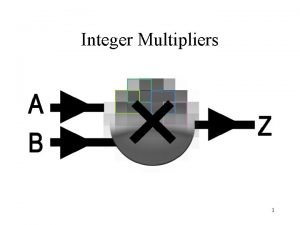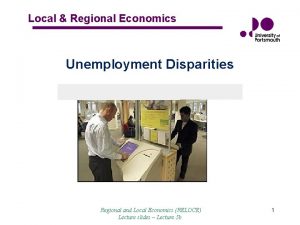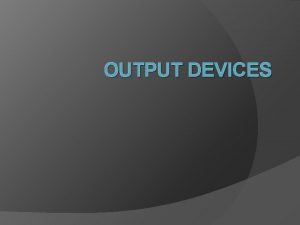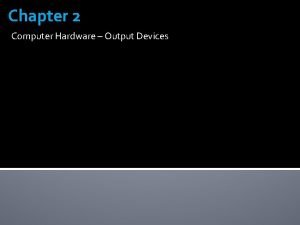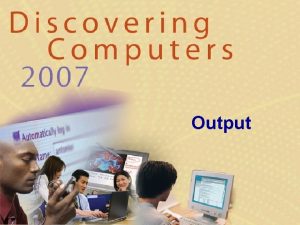Local Regional Economics Lecture 2 a Multipliers output















- Slides: 15

Local & Regional Economics Lecture 2 a Multipliers & output models Regional and Local Economics (RALE) 2010 – Lecture 2 a 1

Local & Regional Economics RALE - Lecture 2 a Last week: Introduction and profiling the local economy This week: part a) Multipliers & output models and part b) econometric models & input-output analysis Aim n To understand how all or some of the economic activity in a local economy is measured. Objective n To be able to understand the multiplier concept n To be familiar with applications of multiplier analysis, its strengths and weaknesses n To be aware of more sophisticated models of income determination Regional and Local Economics (RALE) 2010 – Lecture 2 a 2

Local & Regional Economics The Multiplier Concept Based on the idea that the CUMULATIVE EFFECT of an injection is greater than the INITIAL IMPACT. There are 4 Main effects when a new business starts up New Business starts up 1. Direct effect - Jobs & output from the new plant 2. Indirect effect - via goods & 2 services directly purchased by the new company 3. Induced effect –via the household spending Buys goods & locally by staff of the new services from plant other 4. Feedback loop - as companies in the supply chain 4 to the new business and recipients of household Regional expenditures restock and take and Local Economics (RALE) 2008 – Lecture 2 a on more staff 1 Pays wages to staff 3 3

Local & Regional Economics Export base multiplier § § § Very simplistic early model, domestic sector assumed to service the export sector T=X+D D = d. X where d is a positive constant fraction T = X + d. X or T = (1+d)X 1+d is the multiplier and gives a figure greater than 1 If exports increase by 2 then T output change = 2+(0. 25*2) = 2. 5 Basic (Exporting) 8 Non-basic Domestic 2 Multiplier 1. 25 §Problems – §Does not include external non-export income (wages from abroad) §Sectors are not homogeneous (Production methods are different) §Trying to define what is “export” & what is “domestic” production §Increased output can be met in a variety of ways. (>productivity) Regional and Local Economics (RALE) 2008 – Lecture 2 a 4

Local & Regional Economics Keynesian Income Expenditure approach Based on national income/expenditure accounting framework § § § Y = C + I 0 + G 0 + X 0 - M (Income, consumption and imports are regionally determined) C = C 0 + c. DY (Consumption partially dependent on regional disposable income) M = M 0 + m. DY (Imports dependent on regional disposable income & prop to import) DY = Y – t. Y (Regional disposable income determined by the regional tax rate) Y = k(C 0+I 0+G 0+X 0 -M 0) See Armstrong and Taylor (2000) pp 8 - 15 §The most important feature of the model is the marginal propensity to consume locally produced goods (c-m) §Problems – Size of region – Industry Mix - Location Regional and Local Economics (RALE) 2008 – Lecture 2 a 5

Local & Regional Economics Multiplier process an example Output multiplier of 1. 54 1. The Portsmouth Naval Base directly employs in excess of 26, 000 people, (70% live within 20 miles of the base). 2. The value to the local economy is around £ 500 million p. a. and supports 38, 000 jobs overall. 3. The additional multiplier impact is 12, 000 additional jobs Source CLREA 2005 Regional and Local Economics (RALE) 2010 – Lecture 2 a 6

Local & Regional Economics Use of Keynesian Model – Archibald (FES) Bleaney (examined different groups mpc) Extending the basic model making allowance for transfer payments The multiplicand § Importance of 1 st round leakages - may be large § Examples: Dounreay and Torness + Portsmouth NB Adapted from Armstrong and Taylor (2000) pp 14 Regional and Local Economics (RALE) 2008 – Lecture 2 a 7

Local & Regional Economics Applications of regional multiplier analysis q Sinclair and Sutcliff (1984) effects of tourist expenditure in Malaga (Spain). q Armstrong (1988) multipliers resulting from local economic development initiatives for different companies in local authority areas. q Work by Luger and Goldstein (1996) the forward and backward linkages of Universities. Adapted from Armstrong and Taylor (2000) pp 19 Regional and Local Economics (RALE) 2008 – Lecture 2 a 8

Local & Regional Economics Strengths & Weakness of Regional Multiplier Analysis Strengths § They demonstrate that injections are a process rather than an event § They identify the linkages between sectors Weaknesses § § They do not take capacity constraints into account They fail to allow for interregional feedback effects Time is assumed discrete rather than continuous. They provide a very aggregated picture of the impact of expenditure injections § The ability of the indigenous firms to supply inputs to expanding firms § The role of money Regional and Local Economics (RALE) 2008 – Lecture 2 a 9

Local & Regional Economics A simple multi-regional model of income determination § Weakness of single-region model - it does not account for interregional feedback. § One region's imports are another's exports - therefore income changes are transmitted inter-regionally. Model features § Two regions (north and south) § no supply constraints, output determined by demand for products and services. § Level of output dependant - demand own region, export demand change in (Y) of other region). Regional and Local Economics (RALE) 2008 – Lecture 2 a 10

Local & Regional Economics Two region model with BT function yn A C B ys Regional and Local Economics (RALE) 2008 – Lecture 2 a 11

Local & Regional Economics Consequence of prolonged regional Bo. T Deficit n § § § Although flows of goods and payments are not recorded, they exist and this has severe effects in the real economy. If region has a persistent BOT deficit this must be paid for by one or a combination of the following: Net income transfer into the region by Govt. Residents running down savings. Borrowing from the banking system Selling assets to residents in other regions Long or short-term inward investment to reduce dependence on imports Regional and Local Economics (RALE) 2008 – Lecture 2 a 12

Local & Regional Economics More Sophisticated Models Demand-based model of income and employment World income Assumptions § Positive response to external shocks. § Labour supply elastic at current wage rates. § Spare capacity - output increased without increasing price § Regions are price takers (wages are set nationally) Other regions Demand for region’s output Supply of output Adapted from Armstrong and Taylor (2000) pp 28 Demand for labour Regional employment Regional income External Demand Weakness of the model it Ignores the fact that an increase in demand is likely to affect the price of factor inputs Regional and Local Economics (RALE) 2008 – Lecture 2 a 13

Local & Regional Economics Demand-based model with supply-side World demand Regional income Demand for region’s goods 1. Supply side is endogenous as demand affects the labour market and the supply of output to meet regional and world demand. 2. Wage rate is determined within the region as labour market tightens 3. Increased regional wage rates induces further supply of labour (participation and migration) 4. Increased regional wage rates reduce competitiveness (production costs ) Region’s employment Unemployment Supply of labour Price of region’s goods Wage rate Participation rate Competitiveness of region Net inward migration Regional and Local Economics (RALE) 2008 – Lecture 2 a Adapted from Armstrong and Taylor (2000) pp 30 14

Local & Regional Economics Summary q Cumulative effect on a regional economy is always greater than initial injection but Impact reduces in subsequent rounds q Multiplier combination of Direct, Indirect and Induced effects, there is also a feedback loop. q Keynesian Income Expenditure model is useful for deriving overall regional multipliers. Importance of MPC – size, industry mix, location – can be extended. q Importance of 1 st round injections – applications, universities, tourism, defence etc. q But there are clear weaknesses in the approach. q Multi-regional model shows the inter-connection between regions, further developments have looked at the feedback effect and the supply-side. Next econometric models & input-output analysis Regional and Local Economics (RALE) 2008 – Lecture 2 a 15
 Lagranges equations of undetermined multiplier
Lagranges equations of undetermined multiplier Madas calculator
Madas calculator Two unit multipliers
Two unit multipliers Unit multipliers
Unit multipliers Binary multipliers
Binary multipliers Unit 1 lesson 3 equivalent fractions and multipliers
Unit 1 lesson 3 equivalent fractions and multipliers Fraction chain
Fraction chain Empirical formula multipliers
Empirical formula multipliers Lagrange multipliers
Lagrange multipliers Magic multiplier theory wikipedia
Magic multiplier theory wikipedia Introductory chemistry 5th edition nivaldo j. tro
Introductory chemistry 5th edition nivaldo j. tro 01:640:244 lecture notes - lecture 15: plat, idah, farad
01:640:244 lecture notes - lecture 15: plat, idah, farad Point of presence
Point of presence Principles of economics powerpoint lecture slides
Principles of economics powerpoint lecture slides Land use planning lecture notes
Land use planning lecture notes Health economics lecture notes
Health economics lecture notes
